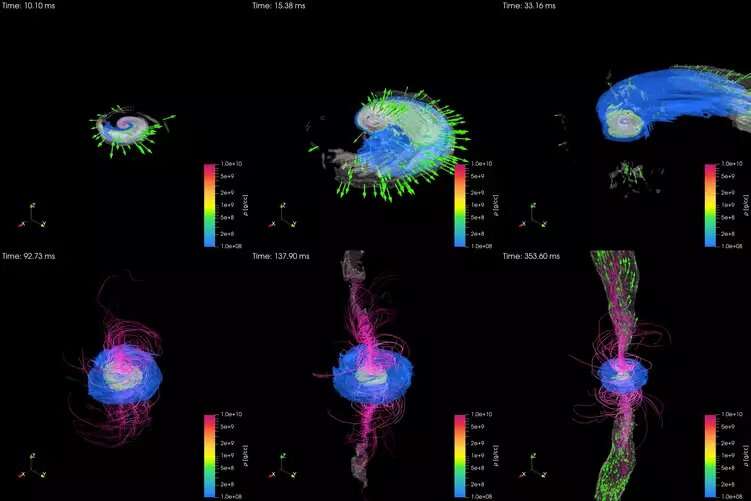Modeling the merger of a black hole with a neutron star and the subsequent process in a single simulation

Using supercomputer calculations, scientists at the Max Planck Institute for Gravitational Physics in Potsdam and from Japan show a consistent picture for the first time: They modeled the complete process of the collision of a black hole with a neutron star. In their studies, they calculated the process from the final orbits through the merger to the post-merger phase in which, according to their calculations, high-energy gamma-ray bursts may occur. The results of their studies have now been published in the journal Physical Review D.
Almost seven years have passed since the first detection of gravitational waves. On September 14, 2015, the LIGO detectors in the U.S. recorded the signal of two merging black holes from the depths of space. Since then, a total of 90 signals have been observed: from binary systems of two black holes or neutron stars, and also from mixed binaries. If at least one neutron star is involved in the merger, there is a chance that not only gravitational-wave detectors will observe the event, but also telescopes in the electromagnetic spectrum.
When two neutron stars merged in the event detected on August 17, 2017 (GW170817), about 70 telescopes on Earth and in space observed the electromagnetic signals. In the two mergers of neutron stars with black holes observed so far (GW200105 and GW200115), no electromagnetic counterparts to the gravitational waves were detected. But when more such events are measured with the increasingly sensitive detectors, the researchers expect electromagnetic observations here as well. During and after the merger, matter is ejected from the system and electromagnetic radiation is generated. This probably also produces short gamma-ray bursts, as observed by space telescopes.
For their study, the scientists chose two different model systems consisting of a rotating black hole and a neutron star. The masses of the black hole were set at 5.4 and 8.1 solar masses, respectively, and the mass of the neutron star was set at 1.35 solar masses. These parameters were chosen so that the neutron star could be expected to be torn apart by tidal forces.
"We get insights into a process that lasts one to two seconds—that sounds short, but in fact a lot happens during that time: from the final orbits and the disruption of the neutron star by the tidal forces, the ejection of matter, to the formation of an accretion disk around the nascent black hole, and further ejection of matter in a jet," says Masaru Shibata, director of the Department of Computational Relativistic Astrophysics at the Max Planck Institute for Gravitational Physics in Potsdam. "This high-energy jet is probably also a reason for short gamma-ray bursts, whose origin is still mysterious. The simulation results also indicate that the ejected matter should synthesize heavy elements such as gold and platinum."
What happens during and after the merger?
The simulations show that during the merger process the neutron star is torn apart by tidal forces. About 80% of the neutron star matter falls into the black hole within a few milliseconds, increasing its mass by about one solar mass. In the subsequent about 10 milliseconds, the neutron star matter forms a one-armed spiral structure. Part of the matter in the spiral arm is ejected from the system, while the rest (0.2–0.3 solar masses) forms an accretion disk around the black hole. When the accretion disk falls into the black hole after the merger, this causes a focused jet-like stream of electromagnetic radiation, which could ultimately produce a short gamma-ray burst.
Seconds-long simulations
It took the department's cluster computer "Sakura" about 2 months to solve Einstein's equations for the process that takes about two seconds. "Such general relativistic simulations are very time-consuming. That's why research groups around the world have so far focused only on short simulations," explains Dr. Kenta Kiuchi, group leader in Shibata's department, who developed the code. "In contrast, an end-to-end simulation, such as the one we have now performed for the first time, provides a self-consistent picture of the entire process for given binary initial conditions that are defined once at the beginning."
Moreover, only with such long simulations the researchers can explore the generation mechanism of short gamma-ray bursts, which typically last one to two seconds.
Shibata and the scientists in his department are already working on similar but even more complex numerical simulations to consistently model the collision of two neutron stars and the phase after the merger.
More information: Kota Hayashi et al, General-relativistic neutrino-radiation magnetohydrodynamic simulation of seconds-long black hole-neutron star mergers, Physical Review D (2022). DOI: 10.1103/PhysRevD.106.023008
Journal information: Physical Review D
Provided by Max Planck Society




















